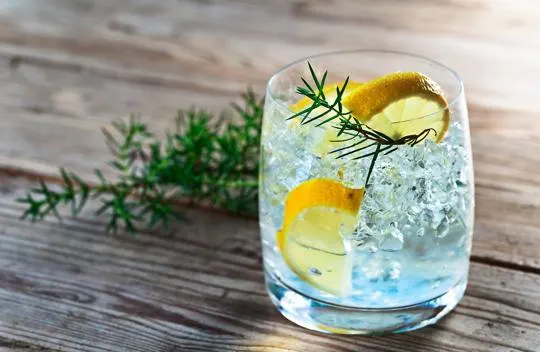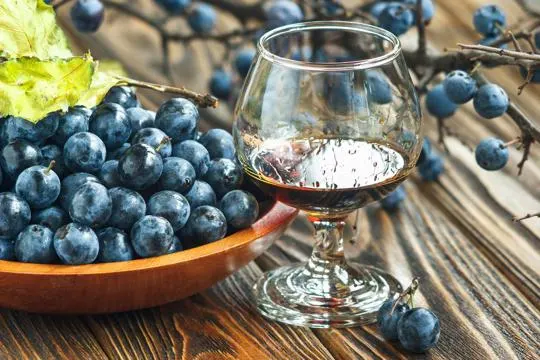Summary of key points
The primary difference between sloe gin and traditional gin is the main flavoring ingredient. Traditional gin is primarily flavored with juniper berries, along with a selection of botanicals, and is distilled. Sloe gin, however, is a liqueur made by infusing gin with sloe berries (the fruit of the blackthorn bush) and sugar, resulting in a sweeter, fruitier flavor profile and lower alcohol content compared to regular gin.
Have you ever stood in the liquor aisle, scratching your head, trying to figure out the brawl between Sloe Gin and regular Gin? Yeah, us too.
They’re like the long-lost cousins who only meet during awkward family reunions. One’s fruity, the other’s herbaceous; they couldn’t be more different if they tried.
Remember that summer we tried to make our own Sloe Gin?
What a disaster. Then there’s Gin. Ah, Gin. It’s the backbone of so many classic cocktails.
The differences go beyond just flavor. It’s all about the base, the ingredients, and the process.
And guess what? We’re here to break it down for you.
No, really. We’ll make it so simple, a toddler could understand.
Stay with us. It’s going to be a fun ride.
What is Gin?

Gin: a spirit with deep historical roots and a beloved, versatile nature.
It’s crafted through a unique distillation process, featuring juniper berries for a pine-like taste and aroma.
And, beyond juniper, it can be flavored with coriander seeds, citrus peels, orris root, and angelica root.
Each brand and recipe has its own botanical combination, creating a variety of tastes.
Gin also has a connection to British culture.
It rose to popularity in the 18th century due to its medicinal qualities.
Over time, it’s adapted—from Dutch genever style to London dry.
Now, it’s a global phenomenon with countless variations.
Gin can be enjoyed on its own or in a classic Gin & Tonic.
It’s also a popular cocktail ingredient, allowing for endless creativity.
In conclusion, gin is an intriguing spirit with captivating flavors.
Its history and adaptability make it a staple in both classic and modern cocktails.
So why not explore the world of gin?
What is Sloe Gin?

Sloe gin is a special type of gin made with sloe berries.
These small, red berries are usually picked in autumn.
They have a tart flavor, so they are steeped in gin and sugar to extract their flavor and add sweetness.
Sloe gin stands out for its ruby color.
This comes from the pigments in the sloe berries, which give it a rich hue.
It’s a feast for your eyes and your taste buds.
Sloe gin tastes different than regular gin. It has a fruity and tangy flavor.
For people who like sweet spirits, sloe gin is an ideal choice. It’s also great in cocktails.
Sloe gin can add something new to classic cocktails like martinis and negronis.
It can also add depth to a sour or give a unique twist to a Collins.
Differences Between Sloe Gin and Gin

Sloe gin and gin: two gins, but different.
Base Spirit
Gin and sloe gin differ in their base spirit. Gin’s base is usually grains, like wheat or barley.
Botanicals are then added to this neutral alcohol, giving it a distinct taste.
These botanicals include juniper berries, coriander seeds, citrus peels, and other herbs and spices.
Sloe gin, on the other hand, is made by infusing sloe berries (wild plums) into gin.
This creates a liqueur with cherry, almond and plum notes, alongside the typical gin flavors.
Base spirit choice affects taste and consumption.
Traditional gin can be drunk neat or in cocktails, while sloe gin is usually enjoyed by itself or as an ingredient in fruit cocktails.
Flavor Profile
Sloe gin and regular gin may look similar, but their flavors set them apart.
Sloe gin has a unique taste that doesn’t come from regular gin.
They both have a juniper base, but sloe gin adds sloe berries for a sweet, fruity twist.
This extra sweetness is great for those who prefer milder or dessert-like cocktails.
Sloe gin offers more than just juniper and fruity notes.
Depending on how it’s distilled and the recipe, it can have hints of almond, plum, or even flowers.
This makes it a versatile choice for mixologists.
It can also be enjoyed neat or used as a base in drinks, like the Sloe Gin Fizz.
Plus, it has a lower alcohol content than traditional gin, making it smoother and great for summer drinks.
In conclusion, sloe gin and regular gin have similarities but their flavor profiles are very different.
Sloe gin’s added sloe berries give it a fruity sweetness and complexities that make it stand out.
Whether you sip it alone or in a mixed drink, try sloe gin for a unique and enjoyable alternative.
Production Process
Sloe gin production is unique from that of regular gin.
Juniper berries are the basis for both, but sloe gin has extra ingredients such as sloe berries and sugar.
It needs to infuse for a few months before it’s ready, so it tastes sweeter and more fruity than regular gin.
This makes it a special choice for cocktail lovers.
If you’re drinking a gin cocktail, why not try sloe gin instead? Experience a different twist on this classic spirit.
Use in Cocktails
Gin is a hit with mixology lovers and bartenders.
Its flavors and uses make it a must-have for many cocktails.
It gives drinks a botanical note and crisp taste.
Sloe gin has a different flavor than regular gin.
It’s distilled with sloe berries, which gives it a sweet, fruity flavor.
So, it can be used to make drinks like the Bramble, with blackberries, lemon juice, and simple syrup.
And the Sloe Gin Fizz, made with sloe gin, lemon juice, sugar syrup, and soda water.
Traditional gin stands out in other drinks.
It’s great in a Martini with dry vermouth.
Or, mixed with tonic water over ice, for the Gin and Tonic – a classic.
Similarities Between Sloe Gin and Gin

Sloe gin and gin have many things in common.
Both are alcoholic drinks that belong to the “gin” family.
And, both contain juniper berries as the main flavoring, giving them a piney taste.
Plus, they both go through a distillation process to concentrate flavors.
These similarities make them alike. But there are differences too.
Sloe gin has ripe sloe berries infused, giving it a sweet, red color and flavor.
Regular gin doesn’t have this.
Plus, while both can be neat or in cocktails, sloe gin is usually used in classic British drinks like Sloe Gin Fizz or Sloe Gin Negroni.
So, both gins have lots in common. But sloe gin stands out because of its infused sloe berries.
If you prefer the classic botanical notes of traditional gin or want something fruity, both are worth exploring.
Popular Brands and Varieties
Popular gin brands and varieties are plentiful.
From London dry gins to craft gins, the selection is vast.
Tanqueray stands out with its distinct flavor and botanical infusion.
This British gin has been around over 180 years and is loved by gin drinkers worldwide.
Its crisp taste and smooth finish make it ideal for classic cocktails and modern mixology.
Hendrick’s is another popular gin.
This Scottish brand is famous for its unique blend of botanicals, such as rose petals and cucumber.
It’s a refreshing, aromatic drink that is frequently enjoyed.
Monkey 47 is a great choice for those seeking something more unconventional.
This German gin features an impressive mix of 47 botanicals.
It has complex flavors, combining floral, fruity, and herbal notes.
Sipsmith is perfect for those who appreciate craftsmanship.
Handcrafted in London, they use traditional methods and the finest ingredients to make superb spirits.
From their classic London dry gin to limited releases, Sipsmith offers something for everyone.
Lastly, Bombay Sapphire is ideal for citrus lovers.
It has ten botanicals, including juniper berries and lemon peel.
The result is a vibrant, zesty gin perfect for summer drinks.
How to Enjoy Sloe Gin and Gin
Gin and sloe gin are two tasty spirits with their own unique characteristics.
Here are some ways to enjoy them:
- Sip neat – slowly savour the flavour and aroma.
- G&T – pour gin over ice, add tonic water and garnish with lime or cucumber.
- Sloe Gin Fizz – mix with lemon juice and soda water, then shake and strain into a glass.
- Martini – stir gin and vermouth with ice, then strain into a martini glass.
- Negroni – equal parts gin, Campari and sweet vermouth in an old-fashioned glass with ice. Garnish with an orange peel.
- Pimm’s – combine sloe gin with Pimm’s No. 1, lemonade and fresh fruits to make a summer punch.
Experiment with different botanicals, infusions and mixers to find your own favourite.
But remember to always drink responsibly.
Conclusion
Sloe gin is an essential spirit for any bar, yet its classification as a liqueur or gin can be confusing.
Both are delicious mixed drinks but keep in mind that sloe gin has more sugar to bring out the sweet notes.
If you’re looking for something refreshing with a hint of sweetness, go for a sloe gin concoction.
If you’re looking for something strong and intense, go for traditional gin.
Thanks to it’s comlex flavor variety, both sloe gin and traditional gins have special place in the world of spirits.
Ultimately, your choice depends on your individual tastes, but history proves sloe gin is worth trying Giving both unique styles of spirits a shot will help you better understand why each has gained such popularity over the last few decades.

Leave a comment